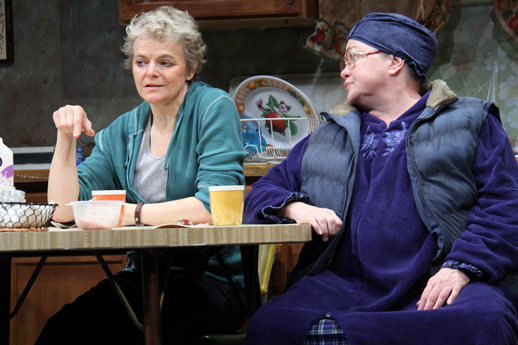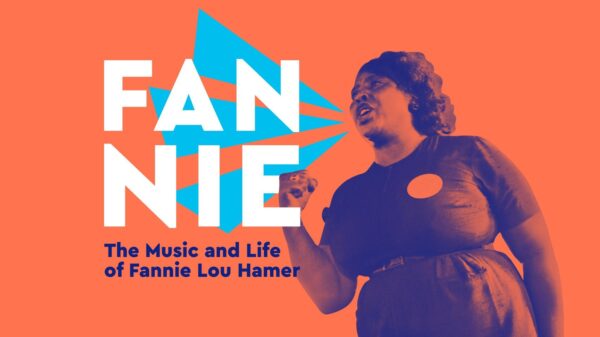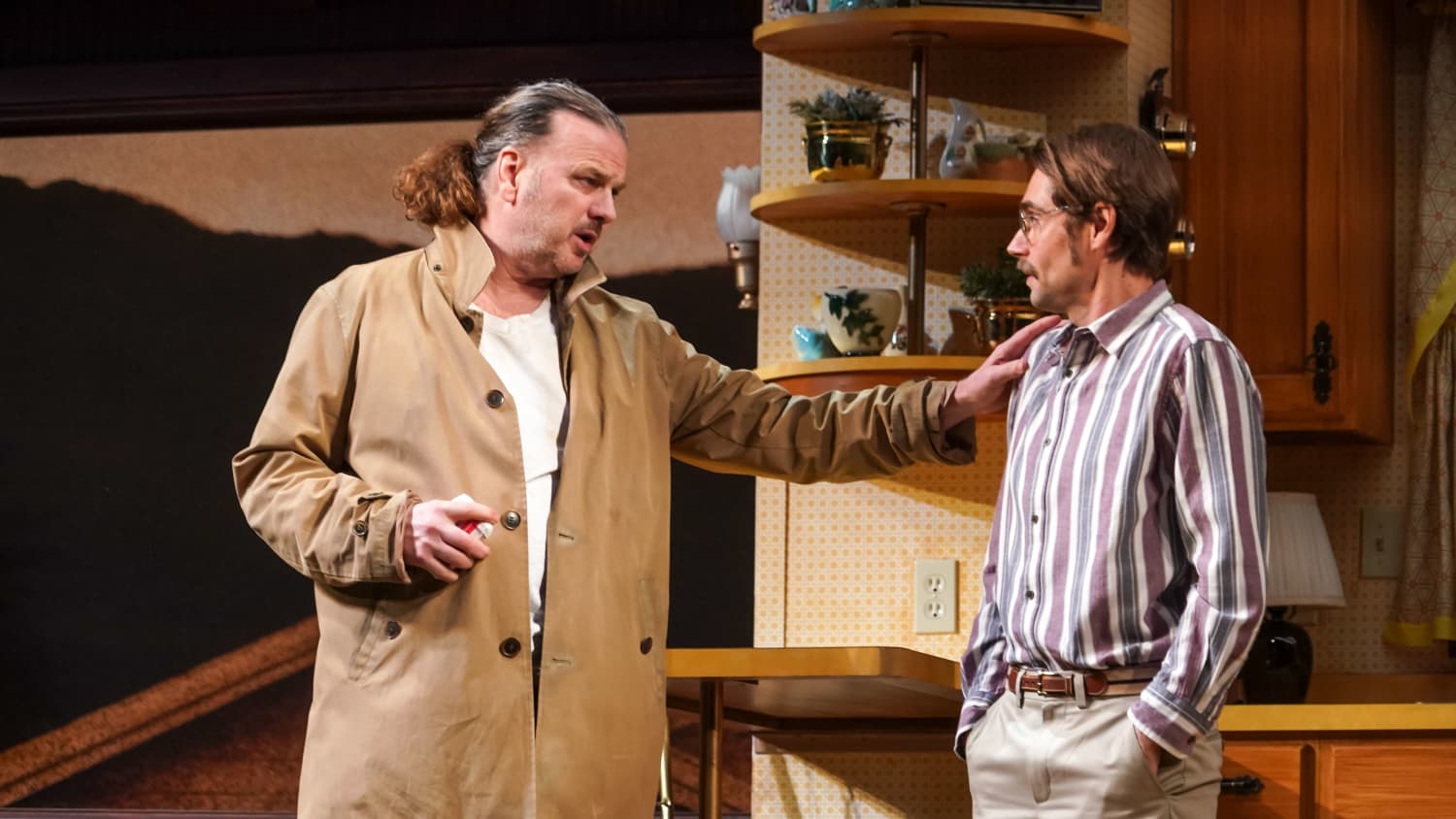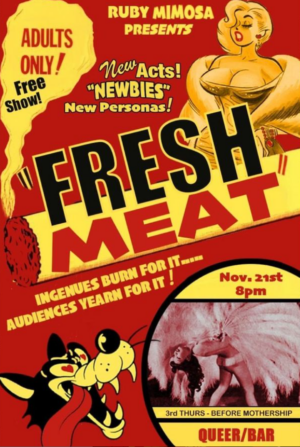
Ellen McLaughlin and Cynthia Lauren Tewes star in Seattle Rep’s current production of David Lindsay-Abaire’s play, “Good People”. Photo by Gerry Goodstein
Review: “Good People” by David Lindsay-Abaire. Produced by Seattle Repertory Theatre. Directed by David Saint. With Ellen McLaughlin, Eric Riedmann, Cynthia Lauren Tewes, Marianne Owen, John Bolger and Zakiya Young. Now through March 31, 2013 at Seattle Rep.
Playwright David Lindsay-Abaire is best known for his Pulitzer Prize winning “Rabbit Hole” (which brought Cynthia Nixon a Tony Award and an Oscar nomination for Nicole Kidman in the film version) but his most recent stage work, “Good People” also earned critical acclaim, including a Tony Award for lead actress, Frances McDormand. It’s not much of a surprise to see why…Mr. Lindsay-Abaire is gifted at crafting multi-layered character pieces that are rich with dramatic tension as well as strong comedic moments and characterizations. It’s also not much of a surprise that his plays are popular with regional theater companies; they have a lot to offer local actors, directors and designers.
Or, not such local talent, as the case might be, with Seattle Repertory’s currently running production of “Good People” which is a co-production with the George Street Playhouse out of New Brunswick, New Jersey. This production opened at George Street back in January before transferring to Seattle for its month long run and features direction by George Street Playhouse artistic director, David Saint, and all the design work was done by that company. The cast includes the highly respected stage actor and playwright, Ellen McLaughlin, best known as the Angel in Tony Kushner’s “Angels in America”, and John Bolger. Seattle based actors Eric Riedmann and Marianne Owen are also in the cast, but it’s definitely a transcontinental production. And, in the case of “Good People”, it works to its advantage. The Rep and George Street Playhouse have been able to put together a Dream Team of theater professionals to craft a superb production; their “Good People” is a tautly directed, superbly designed and immaculately acted piece of theater art and it jumps to the top of the “must not miss” list of local theater.
“Good People” is set in the blue collar neighborhoods of South Boston, where “Southies” are proud of their largely Irish heritage and scrappy determination to survive in a hood plagued by poverty, crime and the ugly memory of racial strife during the late 70’s and 80’s when mandatory busing created strife between the largely white/Irish neighborhoods and neighboring African-American communities. It’s a tough world populated by tough, outspoken people and that community can be both proud and distrustful of those who make it out of the slums of South Boston. The lead character of “Good People” is Margie, and she’s a middle aged single mother with a mentally handicapped daughter and she’s definitely not one of the Southies who’s been allowed to escape; she struggles holding down low wage jobs while trying to care for her daughter and as the play opens, Margie is getting fired from her “Dollar Store” cashier job by the son of someone she grew up in the neighborhood.
Margie is consoled by her loudmouth landlady, Dottie and best friend Jean who lets Margie know that she recently ran into an old boyfriend of Margie’s named Mike who’s now a successful doctor living the good life and Jean suggests that Margie should ask him for a job in his office. With both reluctance and some excitement at seeing her old flame, Margie does meet with Mike and their awkward meeting leads to Mike inviting Margie to his upcoming birthday party in his home. When Mike abruptly calls Margie to announce the party has been canceled due to the illness of his young daughter, Margie is suspicious that Mike is just bailing out on having Margie come to his home because he would be embarrassed by her lower class presence and reminder that he also comes from that background. Margie takes the train to Mike’s house to crash the party…only to discover that he hadn’t been lying; the party had been canceled and Margie finds herself being entertained by Mike and his younger, African-American wife Kate who’s keen to learn more about Mike’s background as a “Southie”. While the evening starts out awkwardly pleasant, it soon turns ugly as some unpleasant truths emerge about Mike and Margie and their former relationship. By the end of the play, it’s up to the audience to decide, who the “Good People” are…the ones who do what’s right for those around them regardless of the consequences. It’s a play about relationships and the sense of community. It’s also about choices and opportunities and doing the right thing for the right reasons regardless if that decision is ultimately beneficial to the person making that decision.
As a play, “Good People” is a solid piece of art with interesting characters, tightly composed dialogue and both dramatic and comedic tension that recalls the “Angry Man” or “Kitchen Sink” dramas of the 1950s and early 1960s where the subject of class inequalities and the struggle to rise above them were very popular on American and British stages. It does teeter on the edge of situation comedy at times; the scenes with the blue collar characters are frequently very funny but they also veer into “Roseanne” territory a time or two, and the second act, almost entirely set in the beautiful suburban home of Mike, where the class divisions between the characters are particularly emphasized, can seem a bit forced. And, a major plot point of the play is Margie’s financial woes and her worry that she and her daughter would end up homeless. Yet, Margie’s daughter is apparently severely mentally handicapped and obviously eligible for considerable government aid, from both the state and federal level and that’s never addressed in the play. At the very least, the daughter would receive disability funds and her mother as primary caregiver would also be eligible for assistance as well, yet Mr. Lindsay-Abaire never alludes to these obvious options. Yes, Margie’s economic struggles are a central driving point of the play, but as government assistance is sadly underfunded, it could still be a mentioned that “it’s not enough” and still maintain the point that Margie needs a job to keep them as comfortable as possible. It sounds like nitpicking, but all drama (and comedy) needs to be based on truth…when it’s shied away from, the foundations of the drama are weakened.
Yes, there are some issues with the basic structure and premise of “Good People” but the essential conflicts of the play are still strongly presented by the text and this particular production. It’s a testament to David Saint’s fine direction, but it’s also largely in the hands of the excellent performances from the entire cast. Eric Riedmann adds another fine entry on his resume with his work as Stevie, the younger man who’s Margie’s (former) boss; it’s a smaller role but one that requires great anger in the opening scene, but quiet resolve in later scenes, and Mr. Riedmann does his usual excellent job of portraying all aspects of the character. Veteran Seattle actress Marianne Owen also gets the job done with her very funny and pragmatic take as Margie’s best friend Jean…it’s an honest and authentic portrayal of a tough but loving working class woman.
On the richer side of the class divided fence, both John Bogar as the former Southie done good, and Zakiya Young as his wife Kate deliver strong performances though both characters are a bit unfairly written as passive/aggressive “good/bad” Yuppie stereotypes. Mr. Bogar is very powerful and very believable as a man who’s climbed over “the fence” from Southie to Establishment and Ms Young does an equally fine job of playing both the sweetness and steel of her character.
But, it’s the work of this play’s leading lady and its principal comic relief that really steal the show. It’s hard to recognize Cynthia Lauren Tewes in her role as the mouthy, elderly and rotundly ribald landlady Dottie; she’s a long ways away from a certain iconic role on a certain iconic ship set romantic television comedy of the late 70s/early 80s. Ms Tewes gives a brilliantly realized and richly comedic performance of great depth and there are times when you wish her Dottie could be spun off into her own play. The audience loves the character and the brilliant performance of the actor playing that character.
The same can also be said for the great Ellen McLaughlin as Margie who gives a fiercely dedicated and passionate performance as a tough but loving woman who has to battle a lot of obstacles in her life in order to survive. Ms McLaughlin is one of this country’s best actors; I’ve been lucky enough to see her in four different productions now, and she never disappoints and she never falters in her dedication to creating richly defined and articulated characters. The accent; the way she carries herself on stage; the layers of meaning behind those characters…they are all impeccably present in her performance. There are many great things in this production, but if all the other elements were dreck but Ms McLaughlin was still front and center, it would still be a production worth seeing.
But, the elements aren’t dreck, and “Good People” is blessed with a brilliant team of designers that include the terrifically appropriate costumes by David Murin, beautiful lighting and projections by Charlie Morrison and evocative sound design and music by Scott Killian. And, one of the principal assets of “Good People” is the spectacular set design by James Youmans which includes the low rent kitchens and bingo halls of South Boston and the immaculately appointed living room of a Chestnut Hill mansion. Designed like a brilliant puzzle box, the different sets emerge like secret drawers full of wonderful but realistic surprise. The Rep prides itself on fantastic set design and the work of Mr. Youmans just raises that bar higher for the theater. Exceptional work from the entire design team.
Yes, it’s a big “Yes” for Seattle Rep/George Street Playhouse’s “Good People”. It’s powerfully acted, designed and directed and Mr. Lindsay-Abaire’s story and rich characters are well worth visiting.




















